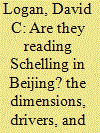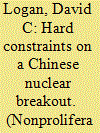|
|
|
Sort Order |
|
|
|
Items / Page
|
|
|
|
|
|
|
| Srl | Item |
| 1 |
ID:
189425


|
|
|
|
|
| Summary/Abstract |
Experts increasingly highlight the dangers of nuclear-conventional entanglement, particularly in the U.S.-China context. This article develops a framework for assessing entanglement and its risks. Applying that framework to China, it finds that Beijing’s missiles are not as entangled as is sometimes feared, but ongoing trends may increase future entanglement. It also presents evidence that, counter to the prevailing wisdom, Chinese entanglement has not emerged as a strategic policy choice but, rather, as the byproduct of more parochial organizational dynamics. Strategic signaling and perception management will be key to controlling escalation risks stemming from nuclear-conventional entanglement in China.
|
|
|
|
|
|
|
|
|
|
|
|
|
|
|
|
| 2 |
ID:
167504


|
|
|
|
|
| Summary/Abstract |
This article applies a form of organizational analysis to the military institution responsible for China’s nuclear weapons, the PLA Rocket Force and its predecessor, the Second Artillery. Analyzing the ways in which this military institution manages and allocates its human capital can offer potential insights into both China’s operational practices and the institutional and strategic priorities of the country’s missile forces. Specifically, the article examines career paths of PLA officers in the Rocket Force, with a particular focus on those officers who eventually rise to the ranks of senior leadership. The analysis yields evidence that senior leaders are more likely to have served in the Rocket Force’s premier conventionally-armed missile base, that there is an informal institutional hierarchy among the missile bases, and that, at least at the personnel level, there is some separation between conventional and nuclear units. These findings have important implications for assessing potential escalation dynamics in a possible conflict between China and the United States and for forecasting the future development of China’s missile forces.
|
|
|
|
|
|
|
|
|
|
|
|
|
|
|
|
| 3 |
ID:
189085


|
|
|
|
|
| Summary/Abstract |
Isaac Kardon and Wendy Leutert argue that China's influence in overseas ports is a “consequential form of state power projection” (p. 10) and an “attractive alternative” (p. 43) to overseas bases.1 They compellingly document China's desire to support peacetime naval operations from People's Republic of China (PRC)–controlled commercial ports, but they overstate both China's “privileged access” (p. 10) to these ports and how the People's Liberation Army Navy (PLAN) has used them. Rather, we argue that access to foreign ports depends on host-nation permission (which is uncertain), and China has not demonstrated that these ports provide robust fleet support. These factors likely impose significant limits on the PLAN's ability to project power from PRC-controlled ports.
|
|
|
|
|
|
|
|
|
|
|
|
|
|
|
|
| 4 |
ID:
156583


|
|
|
|
|
| Summary/Abstract |
Arguments about China's nuclear-modernization program and its implications for US nuclear policy rest on a fundamental misunderstanding. American experts have resurrected fears of a Chinese nuclear “breakout”—defined here as either development of a nuclear-warfighting capability or a significant and rapid increase in the scale of China's nuclear arsenal—to justify significant changes to US nuclear policies. In addition to the “soft” political constraints on China's nuclear arsenal, Beijing also faces a number of “hard” technical constraints, especially on a “sprint to parity” with the United States and Russia. A Chinese nuclear breakout would require significant changes to China's nuclear infrastructure that are likely to be highly detectable. The United States, while being vigilant for indications of a future Chinese nuclear breakout, should also adopt policies that decrease the likelihood of such changes.
|
|
|
|
|
|
|
|
|
|
|
|
|
|
|
|
| 5 |
ID:
186186


|
|
|
|
|
| Summary/Abstract |
Does nuclear superiority offer states political or military benefits? And do those benefits accrue beyond acquiring a secure second-strike capability? International relations theory has long held that nuclear superiority does not confer significant advantages, a conclusion supported by much of the qualitative literature on bargaining and crisis interactions between nuclear-armed states. New work by scholars using statistical methods to analyze data on nuclear crises, interstate disputes, and compellent threats has sought to answer these questions, producing conflicting results. Despite the contributions of these recent works, this line of research has assumed that warhead counts are an appropriate measure of nuclear capabilities and that states possess accurate information about the material balance. Instead, states use multiple quantitative and qualitative characteristics to evaluate the nuclear balance, and they often have inaccurate or incomplete information about the size, composition, and configuration of other states' nuclear forces. Using new data, replications of two prominent recent works show that results are sensitive to how the nuclear balance is operationalized. Drawing on archival and interview data from the United States and the Soviet Union during the Cold War, findings show how states and leaders often understand and respond to the nuclear balance in inconsistent, asymmetric, and subjective ways.
|
|
|
|
|
|
|
|
|
|
|
|
|
|
|
|
|
|
|
|
|